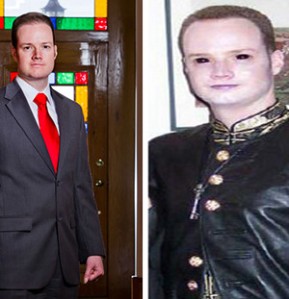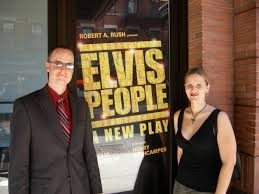There is no Super PAC called “Cosplayers for Congress.” But there should be because there’s a candidate in need of their endorsement.
Jake Rush would like to unseat first-termer Ted Yoho in the Republican primary for Florida’s 3rd Congressional District. His law-and-order creds include: Sheriff’s Deputy, Stand Your Ground defense lawyer, and card-carrying NRA member. He was selected for the West Point Military Academy and SWAT training, but turned both down for the laudably conservative desires to stay near family (the University of Florida is just twenty minutes down the road) and to save tax payer money (SWAT gear is expensive!). He’s also a skilled knife-thrower.
I spent a couple of days in Gainesville last year because the University of Florida is home to one of the largest Comics Studies programs in the country. I gave a conference paper on The Fantastic Four and The Walking Dead. To the best of my knowledge, Rush was not in attendance. He graduated with his Classics major over a decade ago, well before UF or most any college considered comic books a subject worthy of study.
And yet Jake Rush and the UF Department and English must have been drinking from the same superhero-tainted water supply. One of Rush’s recent press releases includes a photograph of himself dressed as the Flash (get it?) and his wife Anne as the Phoenix, a DC-Marvel split ticket unusual in this age of political partisanship.
“There is nothing wrong with being a gamer,” says Rush, while also admitting that it is “kinda nerdy.” He even manages to give cosplay a law enforcement spin: “when applying for undercover work, these hobbies were considered an advantage.” Because what sheriff doesn’t want a deputy with experience dressing up as George Washington, MacBeth, and Jesus?
Rush’s opponents are more interested in the characters not listed on his resume. They include Chazz Darling, Staas van der Winst, and Archbishop Kettering—all vampiric variants in the cosplay sub-universe Mind’s Eye Society. Rush served as a staff member for his Gainesville chapter, which involves wearing a lot of black leather and creepy contact lenses. “I’ve been blessed with a vivid imagination,” he explains, and “raised with a deep appreciation for theatre, costumes and art.” A reporter at the SaintPetersBlog prefers to call it a “bizarre double life,” “one that would rival Jekyll and Hyde.”
Alyssa Rosenberg at the Washington Post defends Rush, arguing that his blood-sucking, cocaine-snorting cosplay is “deliberately transgressive,” and so of course a reserve deputy “would gravitate towards the very things he finds off-limits in his professional capacity.” Some of those off-limit behaviors include Chazz Darling’s rape threats: “I wanted to stick my dick in your mouth to shut you up . . . you’re going to end up naked and sore, tied to the floor of a van marked ‘Free Candy.’” Unless fellow cosplayer Lee Snyder is telling the truth and those messages were posted by a different “Chazz Darling” on his and Rush’s shared account. Either way, the cosplay universe is more complex than a mere Jekyll/Hyde duality.
I prefer Jake’s father Robert Rush’s defense. “Jeez,” he said to a Business Insider reporter, “I guess you might want to put down too that we used to have just great big Halloween parties every year.”
Robert Rush is a law partner and sometime theater producer. I was startled to read in his son’s list of theater creds that he backed the Off-Broadway production of Elvis People by Doug Grissom, a theater professor at the University of Virginia. I wouldn’t be teaching Playwriting now if I hadn’t taken Doug’s Playwriting class while finishing my M.F.A. eight years ago. I asked Doug about Jake.
“WOW!” he emailed back. “Yes, I know his father pretty well – he was the driving force behind producing Elvis People at Mill Mountain as well as New York. Elvis People was his one and only theatrical venture, although now he’s running a kind of ‘CSI’ camp for forensic investigators, which is kind of like a mystery weekend and training course. His main job is being a defense lawyer, and he’s incredibly successful – and rich. I had no idea his son was a right-wing Republican, though – his father Robert usually defends the underclass, he’s radically opposed to things like the death penalty, and frequently is a critic and antagonist of local police agencies. An interesting family, indeed!”
I saw Elvis People during its 2006 premiere in Roanoke, VA. It’s a play about “fan obsession,” and its vignettes include an Elvis impersonator, one of the earliest cosplayers from before the term existed. My favorite scene is between a boyfriend and girlfriend fighting over a button ripped from Presley’s shirt. The two are partners and rivals in desire, both wanting not simply to be with their idol but to be him too. I don’t know if Jake and Anne ever dressed as Elvis, but his press release includes a photo of them at opening night. I prefer the couple in their matching red and gold costumes last Halloween.
I wish I could say I’d endorse the guy, but anyone who attacks his opponent for voting “to fund Obamacare” doesn’t make my superhero list. And the Rand Paul-backed Yoho is the Tea Party guy who called the Affordable Heathcare Act’s tanning booth tax “racist against white people.” So the August 26th Republican primary looks like a lost cause. Now only if Democrats Aquasia Johnson McDowell or Marihelen Wheeler would pose as their favorite superhero and/or demon, Cosplayers for Congress would have a candidate worth supporting.





